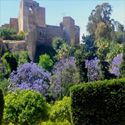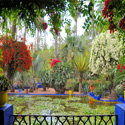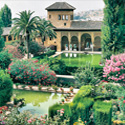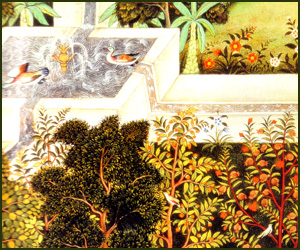Gardens of Islam

|
Throughout the Islamic world there prevails today an excessive
passion for concrete only matched by an equally strong contempt
for greenery. Everywhere the observer is struck by the sight of
greenery in fast retreat; forests devastated for commercial
purposes, or for no purpose at all; orchards uprooted for urban
expansion; gardens and green areas left to abandonment,
vandalised, often depository of urban waste; and so on. Also
common amongst the Muslim communities settled in the West is to
make the concreting of their garden their first deed on the
purchase of a new house. Muslim streets are, in fact, easily
recognisable in most urban places, thoroughly concreted, no
greenery to be seen. Somehow, the impression left to any neutral
observer by this is that Islam is fundamentally hostile to
greenery, and the colour of its flag, green, has been usurped.
Nothing, though, could be further from the truth, as will be
seen in this chapter. And nothing highlights Islam’s love for
greenery than this
instance from early Islamic history noted by
Today’s Muslim twin passion for concrete and hate for greenery
is a new phenomenon in Islamic society. Without elaborating on
this too much, this could be due to the fact that today’s Muslim
ruling elites, one country or two excepted, so obsessed with all
aspects of the material, and devoid of any sort of vision that
deviates from the crude or vile, have an excessive passion for
concrete and an absolute contempt for all things naturally
beautiful. This attitude, of course, they force upon their
people, just as they force other deviant practices, via the
media, education and so on. De-Islamising Muslim society by
these elites, previous colonising powers, and other forces, has
had its effect, too. The violence inflicted by invaders:
crusaders, Mongols, Timur, and Western colonial powers, and
subsequent, secular, Westernised elites in power has forced
Muslims to deviate considerably from their former antecedents
and deeds whether with regard to respect for water as a scarce
resource, love for sciences, gardens, environment etc, in order
to survive.
De-Islamising society has destroyed from within Muslims and
Muslim society what was intrinsic to Muslims: extreme precision,
order, cleanliness of streets and cities, etc. All these have
been suppressed in the course of history, and by force. The
instance highlighted in the preceding section of how Muslims
were forced to de-bath, that is to destroy their baths, has been
generalised to all other aspects of Islam. The brutal colonial
occupation, and loss of fertile lands to colonisation, has
forced Muslims to turn into deforesters par excellence, a
remarkable instance seen in
These shifts in the Muslim psyche and attitude relate to every
aspect of Islamic civilisation, including gardens and gardening,
for indeed, the barrenness and hostility to greenery common
amongst most Muslim societies today is in very sharp contrast to
what prevailed in early Islam, a love, a passion for gardening,
mixed with the art of gardening.
[1]
J. Harvey: Medieval Gardens
(B.T. Batsford
Ltd; London; 1981), p. 37.
[2]
Ibid.
[3]
See, for instance:
-C.R. Ageron:
Histoire de
l’Algerie contemporaine, 3 vols (Presses
Universitaires de France, 1979).
-C.A. Julien:
Histoire de l’Algerie Contemporaine (Presses
Universitaires de France, 1964).
-H Alleg et al:
La Guerre d’Algerie (Temps Actuels, Paris, 1981).
[4]
See:
E. Gibbon:
The Decline and Fall of the Roman Empire; vol 6.
J. Glubb: A Short History; op cit.
[5]
H. C. Lea: The Moriscos of Spain (Burt Franklin,
New York; 1901; 1968 reprint). |





